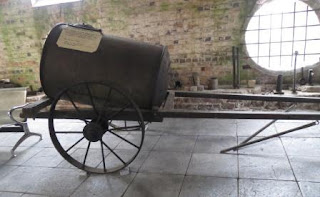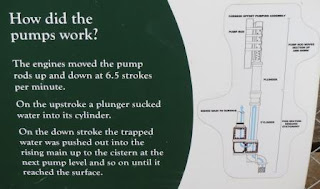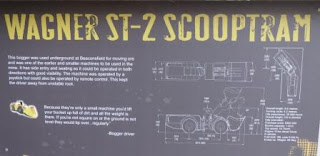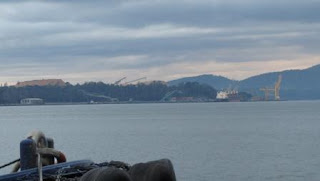Another
cold day with 7 degrees in the van and 3.7 degrees outside at 7.30am. Starting
to cloud over and there is only a small amount of frost. Nice colour as the sun
comes up.
Put
on leggings under the jeans today after freezing yesterday. At 9am it was still
on 6 degrees outside!! The breeze is picking up too. Drove down to Clarence Point esplanade – Mr
Freeman has been here too.
Into
Beaconsfield to check out the museum and mine. The clouds are moving on so
should be a nice day after all. Picked up a history walk brochure so went off
to do that first. Beaconsfield is now a modest apple growing centre in
Tasmania’s north. It was once the wealthiest gold town in Tasmania. It began
its early life as ‘Brandy Creek’ because of the colour of the water in the
creek where the gold was originally discovered.
Stopped
at the park near the museum where there were panels like the ones in Westbury.
And
a waterwheel.
Across
the road was a replica Miner’s Cottage which was all decked out, complete with
hessian ceiling.
Next
to it was a very small building which was the Sidmouth Shop (down the road from
here near the Tamar River). It was the general store and oil depot that service
the orchard and farming areas of the Tamar Valley during the 1930s to 41. The
shopkeeper was Mrs Barbara Swain, whose family conducted a bus service. It was
donated to the museum in 1989 by the Hickman family.
Next
was the Flowery Gully School, 1891 to 1937. It was relocated and erected here
by volunteers in 1977.
I
remember making cotton reel knitting – Dan even did this too.
They
even brought the dunnies.
What’s
left of the original buildings of the gold mines have been saved. The boiler
room on the left and The Hart Shaft.
The
Grubb Shaft 1905.
With
the modern tower over the mine shaft.
Inside
we head into the museum. Info about the last 30 years of the mine.
First
through all kinds of machinery.
Old
apple truck – 1928 Manchester from England, side valve 4 cylinder engine, 16hp,
2.5L.
There
was lots of hands-on machinery. I had a go at turning the handle on a vacuum
pump (c1910) which was used in milking sheds. They couldn’t find the parts to
restore it to full working condition so they added a whistle from a steam
traction engine and a hand wheel from an old laundry mangle. Boy did I laugh
when I turned the handle and it made a farting sound – Steve said it was the
air being sucked in. As I turned the handle faster I made the whistle blow. Should
have taken a video as it sounded so funny when the next lady had a go.
This
looked interesting - Cross Cut Drag Saw (c1928) – very rare single cylinder,
self-propelled on three land wheels.
Next
was a room all about the mining and the tragedy rock fall in 2006.
Climbed
into the tunnel and put my head up to look into the cage that the two miners
were stuck in for all those days. Certainly was cramped. I would have gone mad.
Another
section all about communication. Steve was Superman calling me in the Exchange.
This
collection of 150 wooden knobs was started in 1985 by Ray Porter of
Beaconsfield. They are gathered from within Tasmania and other parts of
Australia.
The
Tassie timbers we have been seeing – even a Manfern.
Another
section about the West Tamar area.
An
apple sorter and corer/peeler. Amazing how someone worked all this out to get
all the wheels etc to do the job. It was one of six used in the Jones and Co
IXL factory at Beauty Point. The factory initially opened during the first
world war for exporting dried apples and later extended its operation to
canning the fruit.
Beauty
Point info.
A
map of historic York Town which is up the road from here and was the first
permanent settlement in northern Tasmania.
Some
sidecar riders racing on Greens Beach.
The
surgical ward always makes us glad we live in this era of time.
Steve
peering out the window of the ‘home’.
Found
out how to make a rag rug.
Into
the next section which was the Grubb Shaft Engine House (built between April
& August, 1905). The massive walls
were needed to support a gantry for a travelling crane. This building, plus the
boiler house and the Hart Shaft building, used 1,050,000 bricks. Including the
shaft work, 13,398m3 of cement was poured. The biggest problem they had with
this mine was there was too much water flooding into the mine shafts. Lots of
information about the mine from 1847 to 1914.
Great
photo of the mine and town looking east taken about 1902.
Lots
of machinery etc to check out.
Some
quartz samples with gold in it, taken from 850 meter level of the Beaconsfield
Mine.
The
doors are made of Pitch Pine which is the strongest and most durable of all the
pine tree family. Used for decks and masts of sailing ships, bridges and
pilings, its high pitch (resin) content ensured a long and useful life. The
pitch pine used without the centre such as these doors, was part of a massive
1500ft (457m) pump rod used in the Tasmanian Mine from 1905 to 1914. The rare
and beautiful timber was supplied by the Hathorn Davey Pump Co of Leeds,
England, who probably obtained the timber from the southern states of USA.
The
people behind the mine.
How
the pump worked. There is a small scale version which works.
Timber
and cage skids etc from the Hart Shaft.
A
scale model of ‘workings’ of the Tasmania Reef, Beaconsfield (1 : 473 -
950mm = 1500ft) when mining ceased in 1914. It’s amazing to think of all
those men that far down underground. The
mine yielded 26.5 tonnes of gold (1878 to 1914)
The
door handle and three locks on the strong room door which was relocated from
the former Luck Bros building in Devonport. It was thought to be on the bullion
room at the Tasmanian Mine Battery at Middle Arm. It weighs more than half a
ton and was made in Launceston.
Into
the next big shed which was the boiler room. The Horse Drawn Water Cart.
A
Clayton Shuttleworth, 12hp portable steam engine, built in 1883 was used at
Ophir Gold Mine, Beaconsfield.
Furphy’s
Farm Water Cart. Earlier models of these horse-drawn water carriers were in
common use in Army cook houses during World War 1. The cook always knew the latest
news, hence in Australian slang, a ‘furphy’ = a rumour or a tall story. The
short-hand on the end of the tank reads ‘Water is a gift from God, but beer is
a concoction of the Devil, don’t drink beer.’
A
much larger version of this Jackass Steam Boiler would have been erected here.
Between
the sheds is the water wheel. Steve pressed the button and it came to life and
then the belts turned the stamper heads which crushed the quartz to retrieve
the gold. Took a video of it working then forgot to take a photo of the wheel
and stamper!!
Out
the building around to the ‘Monkey Cage’ where we look down on the spot where
Todd Russell and Brant Webb emerge from the cage after being trapped deep down
in the mine. They were actually a long way from here, down under the police
station on the main road.
The
supports to keep the old walls erect above where we were in the boiler shed
area.
Down
to the pump area – remaining walls.
Only
the base remains of the huge chimney.
A
miner’s hut, water pump and cradle.
Steve
panning for gold again – and he found some!! Already moulded too!!
The
original Grubb Mine shaft is all collapsed. You can see the pump rods.
The
Engine/Pump house is behind us (where we were before). A plaque outside reads -
This large brick and steel building 79 x 131 feet (24 x 40m) was built in 1905
to house 22 steam boilers, 13 of which were installed. Steam power was used
throughout the mine.
A
time line info board.
Out
onto the newer mine yard. The tripod design of the headframe resulted from a
previous shaft failure due to unstable ground surrounding the shaft. The
likelihood of subsidence meant the headframe may need to be adjusted. By
constructing the headframe as a tripod, it would be easier to adjust than if it
were a square. The tripod also keeps the load well away from the shaft collar.
The
Sheave that guides the winder rope at the top of the headframe. The shaft is
the only way the ore came out and the main way out for the miners. This spare
sheave was always ready for use if needed.
The
ore skip that goes under the cage. It brings about 4.5 tonne of ore to the
surface each time.
The
ore skip and cage lying down.
Steve
escaping from the cage. Concreted in now. Looking up at the cabling above.
Steve taking tag off the board to say he was back on the surface.
Walked
into the area under the headframe where the ore is tip out of the big bucket
and onto the conveyor belt that takes it to the crushing plant. Looking up to
where it would have tipped from.
Where
the ore would have tipped into the container then onto the conveyor belt.
Climbed
up the stairs to look inside where the bucket would slide over these arms to
make it tip out the ore.
Down
the shute – might be some gold stuck in that!! Then down onto the belt.
Looking
up the headframe.
Further
up the stairs was a lookout point with info boards in two directions.
Looking
up to where we were up the stairs.
Into
the Winder House that winds the cable that lifts the cage and bucket up and
down the shaft.
On
one of the legs of the headframe tripod is a small plaque remembering Larry
Knight who died in the rock fall. There wasn’t too much about him – mainly the
two that survived.
The
other side of the headframe with the conveyor belt.
Yes
we did ask this question – where does the poo go!!
Wagner
ST-2 Scooptram. Amazing to think how they get these down the shaft and that
there is enough room down there to drive them around.
Another
important aspect – how they get fresh air.
The
big machines of the old days.
The
small kibble was used during rehabilitation of the shaft. A miner says – ‘Three
of us used to get in and go down the shaft. It was very intimidating the first
time – it’s a long way down. When we used to get down to the job, we’d put
stage boards across the shaft and then we’d shovel all the dirt into this…’ The
bigger one – the miner’s comment – ‘We used to put it half full of dirt because
it’s a long way in and you can’t see nothing!’
Into
the miner’s change rooms. There was a clean entrance and a dirty entrance and
they had to go through the shower room between the too. Oops someone was
showering!!
The
deeper you go underground, the hotter it gets. In Tasmania the geothermal
gradient is about 2.5 degrees Celsius. Every 100 metres you go below the ground
the temperature gets 2.5 degrees hotter. At the 1080 metre level, the
temperature was about 32 degrees C and the humidity, about 90% - sounds like
heaven to us!! The miner’s comment – ‘Some days underground you would get that
bad, you would empty sweat out of your gumboots several times a shift and I
don’t mean a spit full, you empty cup fulls.’
Steve
was amazed how in the early days they reinforced the timber posts by encasing
them with steel.
In
another shed was the drill sharpening workshop.
Don’t
look like these drill bits would cut anything but Steve said they hammer and
grind the rock rather than cut it.
This
gold melting furnace burned 200 litres of diesel an hour to reach the
temperature needed! It was used as Lefroy in the 1980s when the tailings from
the historic gold mines there were being reprocessed.
Back
through the gift shop where I bought a gold charm in the shape of Tasmania.
Back out to the truck looking at the Grubb Shaft (1905) and boiler room then
the Hart Shaft (1904) buildings. The Hart Shaft Engine House once housed the
pumping and winder engines for the Hart Shaft. Only one third of the original
building stands today and has been redeveloped as the winder house for the
current mining operation, Beaconsfield Mine Joint Venture.
Info
board was the first one of the Walk of Gold that we did first.
Looking
at the water wheel and then an old cage and ore skip.
A
plaque commemorating the townspeople of Beaconsfield for the community spirit
throughout the mine tragedy in 2006.
Up
behind the Mine Manger’s residence (now the Council offices) is the site of the
Ballarat Gold Mine – unfortunately they haven’t maintained these info boards. I
had picked up a brochure - In June 1877
the Dally brothers found 47 ounces of gold at Brandy Creek. This started a gold
rush and a year later there were 700 men on the field. In December 1878the
Ballarat United Gold Mining Company was registered with a capital of 4,800 one
pound shares. Beaconsfield’s first mines were alluvial, but water was in short supply
and the ore had to be carted to the creek for sluicing, adding to the cost of
production. When mining went underground, the opposite occurred – there was too
much water! No-one wanted to be the first to put in pumps. They were expensive
to install and operate – and because they mines were so close together, pumping
in one mine would alter the water table in the next shaft and no-one wanted to
benefit his rivals by doing their pumping for them. The Ballarat Gold Mine’s
pumping machinery began operation on 9th December, 1878 and eight
days later the mine was 80 feet deep. The shaft reached its final depth of 210
feet (over 60 metres) in August 1879. The Ballarat Gold Mine is now an
archaeological site – all that remains of Beaconsfield’s small independent
mining operations.
The
site of the shaft.
Where
the boiler room was.
Headed
off back to the truck via Beauty Point. It is the heart of a rich sheep, cattle
and vineyard district. This tiny township was the first deep-water port on the
Tamar River and was first established as a port to service Beaconsfield. The
original wharf, where the first deep-water vessels arrived, is now the site of
the Australian Maritime College. It is also the starting point for the
Launceston to Hobart yacht race held the same time as the Sydney to Hobart
race.
Lots
of little birds have moved in.
Across
the river is the woodchip mill and Comalco at Bell Bay.
5pm
and the sun has gone down so drove home in the dark – so different to when we
first came.
Heater
on and I checked the temp at 10pm, 6.7 degrees.


























































































































































































































No comments:
Post a Comment